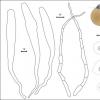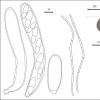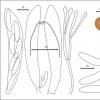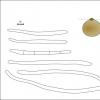
08-01-2026 21:22
 Blasco Rafael
Blasco Rafael
Hola, He recogido esta muestra de Orbilia sobre Re

07-01-2026 10:24
 Danny Newman
Danny Newman
Pezicula sp. on indet. hardwood Appalachian Highl

07-01-2026 22:22
 Danny Newman
Danny Newman
Tatraea sp. on indet. hardwood The Swag, Great Sm

07-01-2026 17:29
 Marc Detollenaere
Marc Detollenaere
Dear Forum,On a barkless Populus I found some smal

10-11-2021 17:33
 Riet van Oosten
Riet van Oosten
Add-on topic http://www.ascofrance.com/forum/7059

07-01-2026 10:05
 Danny Newman
Danny Newman
cf. Chaetospermum on XylariaCosby Campground, Grea

02-01-2026 17:43
MARICEL PATINOHi there, although I couldn't see the fruitbody, I

04-01-2026 17:45
 Stephen Martin Mifsud
Stephen Martin Mifsud
I was happy to find these orange asmocyetes which
Litter of Red cottongrass
Nina Filippova,
04-07-2013 06:10
Surprisingly, litter of Eriophorum russeolum showed other species (from Er. vaginatum). The ecology of these species, and the consistensy of their leaves are quite different, what probably influences fungal species composition. The leaves of Er. russeolum are thicker, but are not abundant, and lie scarcely in sphaghum hollows. Er. russeolum occupies wetter places at the bog, alongside with Scheuchzeria and Carex limosa and hydrophilic sphagna.
Five species collected from its leaves are two pyrenomycetes, two discomycetes and an anamorphic species. Other noticed species are shared with litter of Scheuchzeria (Leptosphaeria sp.) and of Er. vaginatum (anamorphic species with large oval conidia).
This perithecioid species with large spherical perithecia are very impressive. All what you could see at the surface is dark spot, but starting to delve deeper you suddenly realize that there is large balls, perithecia, hidden inside. The structure of hymenium is also very prominent, huge asci, abundant segmented paraphyses and large ellipsoid spores embedded in coating. (#4185 - https://www.cubby.com/pl/%234185/_fe42e98cf28042b9949f9131f75d45c2)
Second perithecioid species not less beautiful. Large two-celled spores with deep constriction are in fissitunicate asci, paraphyses thin and abundant, and the fruitbody is black ball about 200 mk, hidden under epidermis (only pore and dark area seen at the surface). (#4186 - https://www.cubby.com/pl/%234186/_61bcb9064680414cbcd7f41ada3fbac6)
The discoid species (probably Helotiaceae) was met several times at very wet, soft leaves. They are small orangish thick cups, with slightly lighter hymenial surface. Asci show euamyloid reaction of ring, spores are oval and slightly curved, and paraphyses some enlarged at tips and embedded in gelatinous substance. (#4187 - https://www.cubby.com/pl/%234187/_1fa833b8b8dc49788c3e64dd6fbaa242)
Myriosclerotinia sp. grew at fruit stems lying in wet hollows. Brown pubescent discs well seen at the surface. (#4191 - https://www.cubby.com/pl/%234191/_865906158f1141a89af308f04f74503b)
The last encountered species is very strange, probably anamorphic but i had not seen any conidiogenous cells there. The fruitbodies are near globose perithecioid structures. They are hidden under epidermis with darker spot seen at the surface. The conidia (if so) are long vermiform, hyaline, and some of them are septated. They are only the content of fruitbodies, a lot of them are tightly packed inside. (#4189 - https://www.cubby.com/pl/%234189/_81f88eaf6f894cdc979501f93775fa67)







